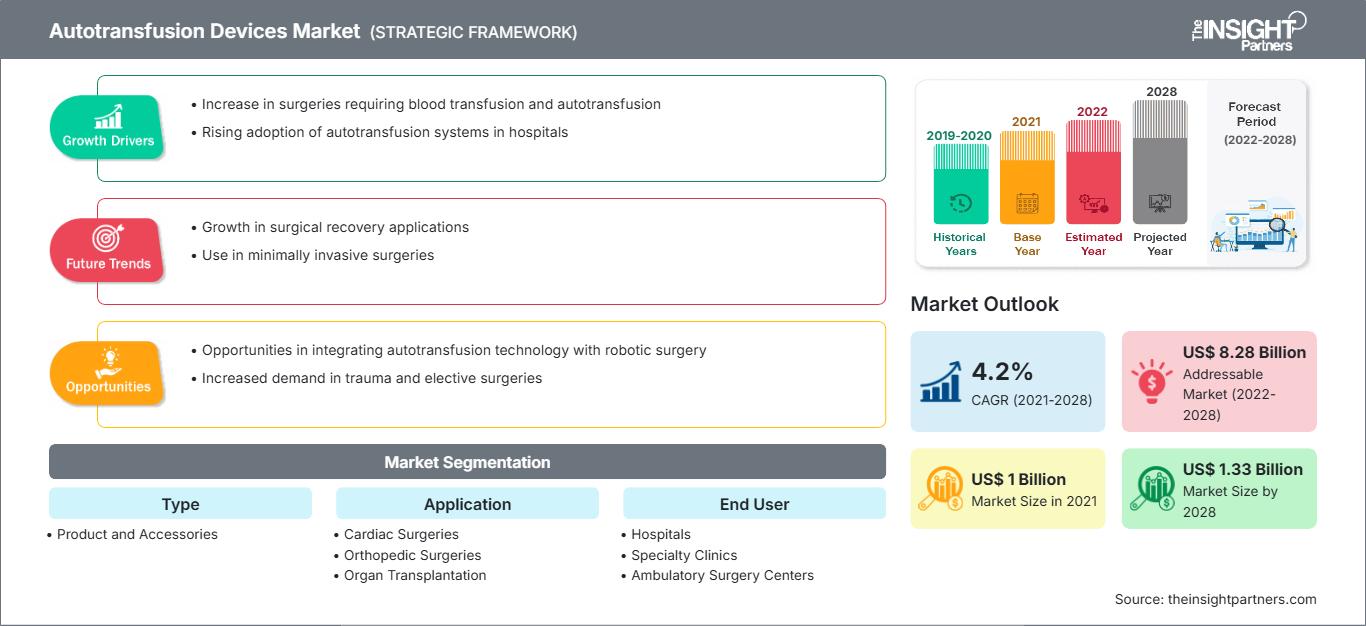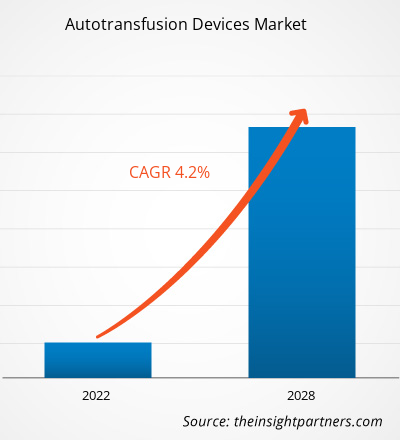预计自体输血设备市场规模将从2021年的10.0026亿美元增长到2028年的13.3199亿美元;预计2021年至2028年的复合年增长率为4.2%。
器官移植是针对器官衰竭而进行的外科手术。通常,器官移植针对的是心脏、肝脏和肾脏等器官;然而,随着慢性疾病病例的增加,其他器官(例如肺、胰腺、角膜和血管组织)也需要移植。这些手术通常需要数小时,并且会大量失血,而自体输血是预防失血的有效方法之一。根据器官共享联合网络 (UNOS) 的数据,美国进行的器官移植数量持续增长,2021 年进行了超过 41,000 例移植手术。同样,根据世界移植登记处的数据,2019 年西班牙占欧盟所有器官捐赠的 20%,占全球捐赠的 6%。近年来,澳大利亚的器官捐赠率有所提高,2019 年每百万人口的器官捐赠率已升至 21.8 人。
自定义此报告以满足您的要求
您将免费获得任何报告的定制,包括本报告的部分内容,或国家级分析、Excel 数据包,以及为初创企业和大学提供超值优惠和折扣
自体输血设备市场: 战略洞察

-
获取本报告的主要市场趋势。这个免费样本将包括数据分析,从市场趋势到估计和预测。
同样,加拿大每百万人口有22.2名器官捐献者,并且还在稳步提升,这部分归功于“器官捐献医生”(负责器官捐献的重症监护医生)的数量。根据世界移植登记处的数据,中国2019年有5818名器官捐献者,即每百万人口4.1名器官捐献者;印度2019年有715名器官捐献者,即每百万人口0.5名器官捐献者。另一方面,俄罗斯的器官捐献率略高,为每百万人口5.1名器官捐献者。与移植协调员合作的公私合作伙伴关系为改善器官移植做出了重大贡献。发展中国家和发达国家的器官移植手术数量都有所增加。例如,印度和新加坡等发展中国家正在成为亚太地区的医疗旅游目的地。各国在提供更优质、更先进的医疗服务方面正在取得进步。因此,器官移植需求的不断增长是推动自体输血设备等移植诊断设备需求的关键因素之一。
自体输血过程涉及患者血液的回输。血液从腹腔或胸腔采集。该过程可以在手术前、手术中和手术后使用自体输血系统进行。关节置换、脊柱手术和心脏手术等医疗程序都需要自体输血。这有助于降低感染风险,还可以消除与储存和输注同源供血相关的问题和并发症。它有助于防止患者传播与输血相关的血液传播疾病。
市场洞察:自体输血设备的技术发展
自体输血设备通常用于长时间手术(例如肾移植)和紧急情况下。这些手术可能会造成过度失血,这使得用新鲜血液弥补失血变得困难,尤其是在稀有血型的情况下。由于需求旺盛,自体输血设备市场的主要参与者提供了先进且全自动的自体输血设备,以减少人工干预。例如,2021年4月,LivaNova PLC的B-Capta已获得美国食品药品监督管理局的批准。在复杂的儿科和成人体外循环手术中,该设备有助于快速准确地监测静脉和血气参数。同样,2019年4月,BD公司在全球推出了其BD BACTEC质控介质,以帮助在输血过程中识别受污染的血小板单位。此外,许多公司采取了收购、合作等战略行动来占领市场。例如,美敦力于 2019 年 10 月收购了 AV Medical Technologies。2019 年 12 月,洁定 (Getinge) 收购了 Applikon Biotechnology,后者是开发和供应从实验室到工业规模的创新生物反应器系统的全球领导者。因此,这些进步可能会在未来几年为自体输血设备市场带来新的趋势。
基于应用的洞察
根据应用,自体输血设备市场细分为心脏手术、骨科手术、器官移植、创伤手术等。心脏手术领域在 2021 年占据了最大的市场份额,而器官移植领域预计在预测期内也将实现最高的复合年增长率。
自体输血设备市场参与者采用产品发布和扩张等有机战略,以扩大其全球影响力和产品组合,并满足不断增长的需求。自体输血设备市场各公司的发展被描述为有机发展和无机发展。各公司都专注于有机增长战略,例如产品发布和业务扩张。自体输血设备市场中常见的无机增长战略是合作伙伴关系和协作。这些增长战略帮助自体输血设备市场参与者拓展业务,并增强了其地域影响力。此外,收购和合作等增长战略有助于巩固客户群并丰富产品组合。各公司采用多种无机增长战略,最大限度地提升了自体输血设备的市场价值和市场地位,从而实现了增长最大化。有机增长占自体输血设备市场总体战略发展的66.67%。而无机增长战略则贡献了公司增长的33.33%。
自体输血设备市场细分如下:
自体输血设备市场根据类型、应用和最终用户进行细分。根据类型,自体输血设备市场分为产品和配件。根据应用,自体输血设备市场可细分为心脏手术、骨科手术、器官移植、创伤手术等。
根据最终用户,自体输血设备市场可分为医院、专科诊所和门诊手术中心。
自体输血设备市场区域洞察
The Insight Partners 的分析师已详尽阐述了预测期内影响自体输血设备市场的区域趋势和因素。本节还讨论了北美、欧洲、亚太地区、中东和非洲以及南美和中美洲的自体输血设备市场细分和地域分布。
自体输血设备市场报告范围
| 报告属性 | 细节 |
|---|---|
| 市场规模 2021 | US$ 1 Billion |
| 市场规模 2028 | US$ 1.33 Billion |
| 全球复合年增长率 (2021 - 2028) | 4.2% |
| 历史数据 | 2019-2020 |
| 预测期 | 2022-2028 |
| 涵盖的领域 |
By 类型
|
| 覆盖地区和国家 |
北美
|
| 市场领导者和主要公司简介 |
|
自体输血设备市场参与者密度:了解其对业务动态的影响
自体输血设备市场正在快速增长,这得益于终端用户需求的不断增长,而这些需求的驱动因素包括消费者偏好的演变、技术进步以及对产品优势的认知度的提升。随着需求的增长,企业正在扩展产品线,不断创新以满足消费者需求,并抓住新兴趋势,从而进一步推动市场增长。

- 获取 自体输血设备市场 主要参与者概述
- BD
- Braile Biomedica
- Fresenius SE & Co. KGaA
- Haemonetics Corporation
- LivaNova PLC
- Medtronic
- Redax SpA
- SARSTEDT AG and Co. KG
- Teleflex Incorporated
- Zimmer Biomet
- 历史分析(2 年)、基准年、预测(7 年)及复合年增长率
- PEST和SWOT分析
- 市场规模、价值/数量 - 全球、区域、国家
- 行业和竞争格局
- Excel 数据集
近期报告
客户评价
购买理由
- 明智的决策
- 了解市场动态
- 竞争分析
- 客户洞察
- 市场预测
- 风险规避
- 战略规划
- 投资论证
- 识别新兴市场
- 优化营销策略
- 提升运营效率
- 顺应监管趋势






















 获取免费样品 - 自体输血设备市场
获取免费样品 - 自体输血设备市场